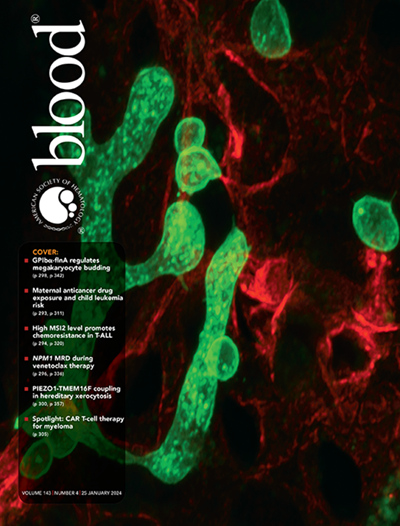Clinical presentation, management, and outcome of TIAN in CNS lymphoma treated with CD19-CAR T-cell Therapy.
IF 21
1区 医学
Q1 HEMATOLOGY
引用次数: 0
Abstract
Tumor inflammation-associated neurotoxicity (TIAN) was recently proposed as a unique complication of immunotherapy in brain tumor patients. Here, we report a first comprehensive characterization of TIAN in CNS lymphoma (CNSL) patients treated with CD19-directed chimeric antigen receptor T-cells (CD19-CAR). TIAN occurred in 10/56 (17.9%) CNSL with clinical onset at a median 3.5 days (range: 1-9) after CD19-CAR infusion. It was less frequently associated with cytokine release syndrome (60% vs 100%, p = 0.009) than immune effector cell-associated neurotoxicity syndrome (ICANS). Although symptoms were usually transient and fully reversible, TIAN was associated with a fatal outcome in one patient. Larger CNS tumor volume at baseline allowed the identification of patients at risk for TIAN (AUC: 0.847, p = 0.002). Maximizing Youden J statistics, a discriminatory tumor volume threshold >3.4cm3 was determined, which carried 87.5% sensitivity and 80.5% specificity. TIAN correlated with higher overall response rates to CD19-CAR (90% vs 52%, p = 0.036) and improved progression-free survival (Hazard ratio: 0.22; 95%-Confidence interval: 0.07-0.61, p = 0.006) on multivariate Cox proportional hazard regression. Post-mortem histopathological evaluation of a TIAN lesion revealed a dense macrophage population with central necrosis and peripheral reactive gliosis, accompanied by loss of white matter and intracytoplasmic myelin in foamy macrophages. Collectively, our work supports TIAN as a localized on-tumor, on-target neurotoxicity syndrome, closely related to pre-existing CNSL lesions and distinct from ICANS. CNS tumor volume at baseline may allow to identify patients at risk and may guide management.CD19-CAR - t细胞治疗中枢神经系统淋巴瘤的临床表现、治疗和结果
肿瘤炎症相关神经毒性(TIAN)最近被认为是脑肿瘤患者免疫治疗的独特并发症。在这里,我们首次报道了用cd19靶向嵌合抗原受体t细胞(CD19-CAR)治疗的中枢神经系统淋巴瘤(CNSL)患者中TIAN的全面表征。TIAN发生在10/56 (17.9%)CNSL中,临床发病时间中位数为CD19-CAR输注后3.5天(范围:1-9)。与免疫效应细胞相关神经毒性综合征(ICANS)相比,它与细胞因子释放综合征的相关性较低(60% vs 100%, p = 0.009)。虽然症状通常是短暂的和完全可逆的,但在一名患者中,田与致命的结果有关。基线时较大的中枢神经系统肿瘤体积可以识别有TIAN风险的患者(AUC: 0.847, p = 0.002)。利用约登J统计量,确定肿瘤体积鉴别阈值>3.4cm3,敏感性87.5%,特异性80.5%。TIAN与更高的CD19-CAR总有效率(90% vs 52%, p = 0.036)和改善的无进展生存期相关(风险比:0.22;95%可信区间:0.07-0.61,p = 0.006)。死后对TIAN病变的组织病理学评估显示密集的巨噬细胞群,伴有中央坏死和周围反应性胶质瘤,并伴有泡沫巨噬细胞中白质和胞浆内髓磷脂的丢失。总的来说,我们的工作支持TIAN是一种局部肿瘤上、靶标上的神经毒性综合征,与已有的CNSL病变密切相关,与ICANS不同。中枢神经系统肿瘤在基线时的体积可以识别有风险的患者,并可以指导治疗。
本文章由计算机程序翻译,如有差异,请以英文原文为准。
求助全文
约1分钟内获得全文
求助全文
来源期刊

Blood
医学-血液学
CiteScore
23.60
自引率
3.90%
发文量
955
审稿时长
1 months
期刊介绍:
Blood, the official journal of the American Society of Hematology, published online and in print, provides an international forum for the publication of original articles describing basic laboratory, translational, and clinical investigations in hematology. Primary research articles will be published under the following scientific categories: Clinical Trials and Observations; Gene Therapy; Hematopoiesis and Stem Cells; Immunobiology and Immunotherapy scope; Myeloid Neoplasia; Lymphoid Neoplasia; Phagocytes, Granulocytes and Myelopoiesis; Platelets and Thrombopoiesis; Red Cells, Iron and Erythropoiesis; Thrombosis and Hemostasis; Transfusion Medicine; Transplantation; and Vascular Biology. Papers can be listed under more than one category as appropriate.
 求助内容:
求助内容: 应助结果提醒方式:
应助结果提醒方式:


